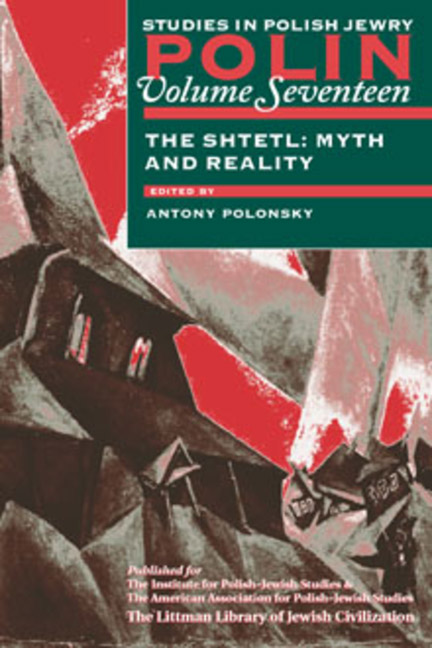Book contents
- Frontmatter
- Dedication
- Editors and Advisers
- Preface
- Polin
- Polin: Studies inPolish Jewry
- Contents
- Note on Place Names
- Note on Transliteration
- List of Abbreviations
- PART I THE SHTETL: MYTH AND REALITY
- Introduction. The Shtetl: Myth and Reality
- The Shtetl as an Arena for Polish–Jewish Integration in the Eighteenth Century
- Inter-Religious Contacts in the Shtetl: Proposals for Future Research
- The Hasidic Conquest of Small-Town Central Poland, 1754–1818
- The Drama of Berdichev: Levi Yitshak and his Town
- Polish Shtetls under Russian Rule, 1772–1914
- How Jewish Was the Shtetl?
- The Changing Shtetl in the Kingdom of Poland during the First World War
- The Shtetl: Cultural Evolution in Small Jewish Towns
- Small Towns in Inter-War Poland
- Jewish Patrons and Polish Clients: Patronage in a Small Galician Town
- Maintaining Borders, Crossing Borders: Social Relationships in the Shtetl
- The Soviet Shtetl in the 1920s
- Shtetl and Shtot in Yiddish Haskalah Drama
- Kazimierz on the Vistula: Polish Literary Portrayals of the Shtetl
- Imagining the Image: Interpretations of the Shtetl in Yiddish Literary Criticism
- Shtetl Codes: Fantasy in the Fiction of Asch, Schulz, and I. B. Singer
- Returning to the Shtetl: Differing Perceptions
- PART II NEW VIEWS
- PART III DOCUMENTS
- PART IV THE SIXTY-FIFTH ANNIVERSARY OF EVENTS IN PRZYTYK: A DEBATE
- PART V REVIEWS
- OBITUARIES
- Notes on the Contributors
- Glossary
- Index
The Shtetl: Cultural Evolution in Small Jewish Towns
from PART I - THE SHTETL: MYTH AND REALITY
- Frontmatter
- Dedication
- Editors and Advisers
- Preface
- Polin
- Polin: Studies inPolish Jewry
- Contents
- Note on Place Names
- Note on Transliteration
- List of Abbreviations
- PART I THE SHTETL: MYTH AND REALITY
- Introduction. The Shtetl: Myth and Reality
- The Shtetl as an Arena for Polish–Jewish Integration in the Eighteenth Century
- Inter-Religious Contacts in the Shtetl: Proposals for Future Research
- The Hasidic Conquest of Small-Town Central Poland, 1754–1818
- The Drama of Berdichev: Levi Yitshak and his Town
- Polish Shtetls under Russian Rule, 1772–1914
- How Jewish Was the Shtetl?
- The Changing Shtetl in the Kingdom of Poland during the First World War
- The Shtetl: Cultural Evolution in Small Jewish Towns
- Small Towns in Inter-War Poland
- Jewish Patrons and Polish Clients: Patronage in a Small Galician Town
- Maintaining Borders, Crossing Borders: Social Relationships in the Shtetl
- The Soviet Shtetl in the 1920s
- Shtetl and Shtot in Yiddish Haskalah Drama
- Kazimierz on the Vistula: Polish Literary Portrayals of the Shtetl
- Imagining the Image: Interpretations of the Shtetl in Yiddish Literary Criticism
- Shtetl Codes: Fantasy in the Fiction of Asch, Schulz, and I. B. Singer
- Returning to the Shtetl: Differing Perceptions
- PART II NEW VIEWS
- PART III DOCUMENTS
- PART IV THE SIXTY-FIFTH ANNIVERSARY OF EVENTS IN PRZYTYK: A DEBATE
- PART V REVIEWS
- OBITUARIES
- Notes on the Contributors
- Glossary
- Index
Summary
THE territory of Poland has changed considerably over the course of history. From the sixteenth century on it was called the Republic of Two Nations, though in fact it was a federation of four lands: Poland, Lithuania, Belarus, and a large section of Ukraine (including Bessarabia). The densest settlement of Jews in Europe was in these territories. When the Polish Commonwealth lost its independence in the partitions of 1772, 1792, and 1795, the greater part of the Jewish population inhabited central Poland, Belarus, and Ukraine, with a much smaller population in Lithuania. The Jews then became subjects mainly of Russia and Austria. Russian restrictions on Jewish settlement resulted in the establishment of the Pale of Settlement. The legal status of the Pale's inhabitants differed from that of the Jews in central Poland and in the Polish lands under Austrian rule.
The long history of coexistence between Jews and Slavs in the Polish Commonwealth involved the emergence of many cultural centres specific to each of the ethnic groups. Until the nineteenth century it was rare for a city or town to serve as a cultural centre for more than one group. The political and administrative significance of Warsaw in the pre-partition period was obvious to the Poles, but for the Jews the city's importance was exclusively economic. In the seventeenth and eighteenth centuries Brody and Berdyczów were important centres of Jewish culture, but not of Polish or Ukrainian culture. As Zamość rose in significance for Jews, its status in Polish eyes was reduced to that of a provincial town. This situation was due as much to legal restrictions (some cities or regions had de non tolerandis Judaeis privileges until the mid-nineteenth century1) as to the isolation of the Jews as a group from Christians.
The process of urbanization was different for the two groups. The economic decline of medium-sized cities in the eighteenth century brought in its wake a reduction of the number of Christian inhabitants and led to their agrarianization. On the other hand, the Jewish populations grew in the towns. Following the partitions, the expulsion of Jews from the lands under Prussian rule, and their eviction from villages under the Russian administration, the Jewish population of many towns of central Poland and the Pale of Settlement reached 50 per cent or more.
- Type
- Chapter
- Information
- The Shtetl: Myth and Reality , pp. 133 - 142Publisher: Liverpool University PressPrint publication year: 2004



